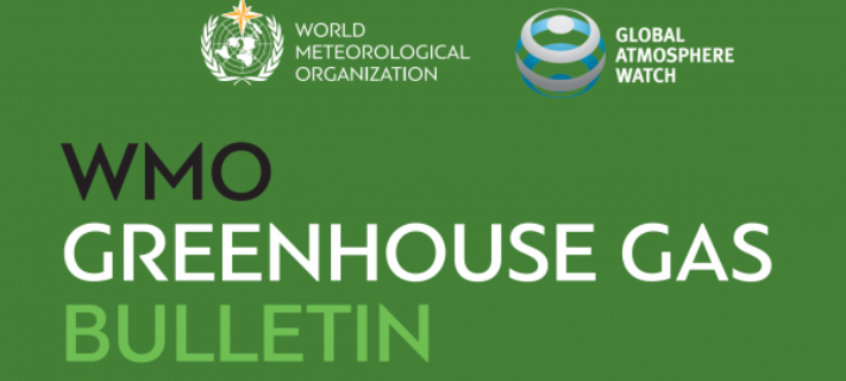2023 Greenhouse Gas Bulletin: A Wake-Up Call for Global Climate Action (GS Paper 3, Environment)

Context
- The World Meteorological Organization (WMO) has recently released its 2023 Greenhouse Gas (GHG) Bulletin, offering critical insights into the state of global atmospheric composition.
- This bulletin presents the latest data from the WMO’s Global Atmosphere Watch (GAW) programme, highlighting concerning trends in the levels of major greenhouse gases such as carbon dioxide (CO₂), methane (CH₄), and nitrous oxide (N₂O).
What Are Greenhouse Gases?
Greenhouse gases (GHGs) are essential for life on Earth, as they trap heat in the atmosphere, maintaining the planet's temperature. However, human activities have significantly amplified the natural greenhouse effect, leading to global warming and climate change. Key GHGs include:
- Carbon dioxide (CO₂): The largest contributor to global warming, primarily released through the burning of fossil fuels, deforestation, and industrial activities.
- Methane (CH₄): Emitted during activities like livestock farming, waste management, rice cultivation, and fossil fuel extraction.
- Nitrous oxide (N₂O): Released through agriculture, land use practices, and the burning of fossil fuels.
- Water vapour (H₂O): The most abundant GHG, though it has a relatively short atmospheric lifespan.
- Industrial fluorinated gases: Such as hydrofluorocarbons (HFCs), perfluorocarbons (PFCs), and sulfur hexafluoride (SF₆), which have an extremely high global warming potential.
Key Findings from the 2023 GHG Bulletin
The 2023 GHG Bulletin paints a grim picture of the state of Earth's climate:
- Record Levels of GHGs: The levels of CO₂, CH₄, and N₂O reached new highs globally in 2023. Specifically, CO₂ concentration increased by 2.3 parts per million (ppm), reaching 420 ppm, marking a continuous rise for the 12th consecutive year.
- Warming Trend: 2023 has been recorded as the warmest year ever, with global temperatures 1.48°C above the pre-industrial levels of 1850-1900. This surpasses the previous temperature record set in 2016.
- Historical Context: CO₂ levels are now comparable to those seen 3-5 million years ago when temperatures were 2-3°C higher and sea levels were significantly higher than today.
- Role of El Niño: The occurrence of El Niño in 2023 further exacerbated the warming trend, leading to drier conditions, increased wildfires, and more GHG emissions. These climatic shifts hindered the Earth’s natural carbon sinks, such as forests and oceans, from absorbing CO₂ effectively.
The Vicious Cycle of Climate Change
- The WMO warns that the ongoing increase in GHGs could trigger a vicious cycle.
- As global temperatures rise, ecosystems that act as carbon sinks—like forests and oceans—may become sources of emissions themselves, releasing more carbon and further exacerbating global warming.
- This cycle of feedback mechanisms threatens to accelerate climate change beyond manageable levels.
Methane: The Growing Threat
- In addition to CO₂, methane has emerged as a significant concern.
- From 2020 to 2022, methane levels saw their largest increase in three years, driven in part by La Niña conditions, which created wetter and warmer conditions in certain regions, especially wetlands.
- Methane, a potent GHG, has a global warming potential 25 times greater than CO₂, making its increase a major driver of climate change.
Global Efforts to Tackle Emissions
- Despite global recognition of the climate crisis, the latest assessments indicate that national emission reductions are falling short of targets set under the Paris Agreement.
- According to the United Nations Framework Convention on Climate Change (UNFCCC), the collective emissions reduction pledges, known as Nationally Determined Contributions (NDCs), are expected to reduce emissions by just 2.6% between 2019 and 2030—far from the 43% reduction needed to limit global warming to 1.5°C.
- To address this, the UNFCCC has called for more ambitious and timely updates to NDCs, urging nations to enhance their commitments before the deadline in February 2024.
The Role of Global Atmosphere Watch (GAW)
- The Global Atmosphere Watch (GAW) is a critical component of the WMO’s efforts to understand and mitigate climate change.
- This collaborative programme, involving over 100 countries, monitors the atmospheric composition, providing valuable data on GHG concentrations, aerosols, ozone levels, UV radiation, and more.
- The data collected by GAW informs climate change research, air pollution mitigation strategies, and international climate policies.
- GAW’s work supports global efforts to reduce emissions and combat environmental degradation by providing a scientific foundation for policy development and fostering international cooperation.
What Can Be Done?
To reverse or at least slow the trajectory of climate change, stronger and more immediate actions are necessary. Several international frameworks and national initiatives are already in place to combat GHG emissions:
International Initiatives:
- Kyoto Protocol and Paris Agreement: International agreements aimed at reducing global carbon emissions.
- International Solar Alliance: Promotes solar energy to reduce dependence on fossil fuels.
- Global Biofuel Alliance: Supports the use of sustainable biofuels to reduce emissions.
India's Efforts:
- Bharat Stage-VI (BS-VI) Emission Norms: Stricter vehicle emission standards.
- National Action Plan on Climate Change (NAPCC): A framework for addressing climate change through eight national missions.
- Energy Conservation Act 2022: Aims to promote energy efficiency and reduce emissions.
- Panchamrit Goal: India’s climate action plan that includes commitments to reduce emissions and transition to clean energy.
Conclusion
- The 2023 WMO Greenhouse Gas Bulletin serves as a stark reminder of the urgent need for global action on climate change.
- With GHG concentrations reaching record levels and global temperatures rising, the window for limiting the worst impacts of climate change is rapidly closing.
- Strengthened policy measures, enhanced international cooperation, and updated national emission pledges are essential to ensure a sustainable and habitable future for all.


